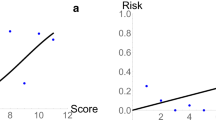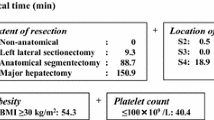Abstract
Grading of difficulty is needed for laparoscopic liver resection (LLR). Indications for LLR are expanding worldwide from minor to major resections, particularly in institutions having surgeons with advanced skills. If the degrees of surgical difficulty were defined, it would serve as a useful guide when introducing LLR and stepping up to the more advanced LLR. As no previous study has addressed the degrees of difficulty of various LLR procedures, we devised a practical scoring system for this purpose. We extracted the following five factors from preoperative information to score difficulty levels: (1) tumor location, (2) extent of liver resection, (3) tumor size, (4) proximity to major vessels, and (5) liver function. This difficulty index is comprised of the cumulative score for the five individual factors. There has not yet been a standard definition of difficulty. Our proposed scoring system might be a practical means of assessing the difficulty of LLR procedures. However, this system must be prospectively validated.




Similar content being viewed by others
References
Troisi RI, Montalti R, Van Limmen JGM et al (2014) Risk factors and management of conversions to an open approach in laparoscopic liver resection: analysis of 265 consecutive cases. HPB 16(1):75–82
Adnet F, Borron SW, Racine SX, Clemessy JL, Fournier JL, Plaisance P, Lapandry C (1997) The intubation difficulty scale (IDS): proposal and evaluation of a new score characterizing the complexity of endotracheal intubation. Anesthesiology 87(6):1290–1297
Osborne SA, Severn P, Bunce CV, Fraser SG (2006) The use of a pre-operative scoring system for the prediction of phacoemulsification case difficulty and the selection of appropriate cases to be performed by trainees. BMC Ophthalmol 6:38
Collado V, Nicolas E, Hennequin M (2008) Dental difficulty for adult patients undergoing different dental procedures according to level of dental anxiety. Odontostomatol Trop 31(124):35–42
Lee Iv MK, Gao F, Strasberg SM (2015) Perceived complexity of various liver resections: results of a survey of experts with development of a complexity score and classification. J Am Coll Surg 220(1):64–69
Beller S, Eulenstein S, Lange T, Niederstrasser M, Hünerbein M, Schlag PM (2009) A new measure to assess the difficulty of liver resection. Eur J Surg Oncol (EJSO) 35(1):59–64
Hansen C, Zidowitz S, Ritter F, Lange C, Oldhafer K, Hahn HK (2013) Risk maps for liver surgery. Int J Comput Assist Radiol Surg 8(3):419–428
Buell JF, Cherqui D, Geller DA et al (2009) The international position on laparoscopic liver surgery: the Louisville Statement, 2008. Ann Surg 250(5):825–830
J-h Ai, J-w Li, Chen J, Bie P, S-g Wang, Zheng S-G (2013) feasibility and safety of laparoscopic liver resection for hepatocellular carcinoma with a tumor size of 5–10 cm. PLoS One 8(8):e72328
Shelat V, Cipriani F, Basseres T, Armstrong T, Takhar A, Pearce N, AbuHilal M (2015) Pure laparoscopic liver resection for large malignant tumors: does size matter? Ann Surg Oncol 22(4):1288–1293
Cho JY, Han H-S, Yoon Y-S, Shin S-H (2008) Feasibility of laparoscopic liver resection for tumors located in the posterosuperior segments of the liver, with a special reference to overcoming current limitations on tumor location. Surgery 144(1):32–38
Xiang L, Xiao L, Li J, Chen J, Fan Y, Zheng S (2015) Safety and feasibility of laparoscopic hepatectomy for hepatocellular carcinoma in the posterosuperior liver segments. World J Surg 39(5):1202–1209
Sarpel U, Hefti MM, Wisnievsky JP, Roayaie S, Schwartz ME, Labow DM (2009) Outcome for patients treated with laparoscopic versus open resection of hepatocellular carcinoma: case-matched analysis. Ann Surg Oncol 16(6):1572–1577
Ban D, Tanabe M, Ito H, Otsuka Y, Nitta H, Abe Y, Hasegawa Y, Katagiri T, Takagi C, Itano O, Kaneko H, Wakabayashi G (2014) A novel difficulty scoring system for laparoscopic liver resection. J Hepatobiliary Pancreat Sci 21(10):745–753
Wakabayashi G, Cherqui D, Geller DA et al (2015) Recommendations for laparoscopic liver resection: a report from the second international consensus conference held in morioka. Ann Surg 261(4):619–629
Hibi T, Cherqui D, Geller DA, Itano O, Kitagawa Y, Wakabayashi G (2014) International survey on technical aspects of laparoscopic liver resection: a web-based study on the global diffusion of laparoscopic liver surgery prior to the 2nd international consensus conference on laparoscopic liver resection in Iwate, Japan. J Hepatobiliary Pancreat Sci 21(10):737–744
Farges O, Goutte N, Dokmak S et al (2014) How surgical technology translates into practice: the model of laparoscopic liver resections performed in France. Ann Surg 260(5):916–921
Glarner CE, McDonald RJ, Smith AB et al (2013) Utilizing a novel tool for the comprehensive assessment of resident operative performance. J Surg Edu 70(6):813–820
Larson JL, Williams RG, Ketchum J, Boehler ML, Dunnington GL (2005) Feasibility, reliability and validity of an operative performance rating system for evaluating surgery residents. Surgery 138(4):640–647
Ahmed K, Miskovic D, Darzi A, Athanasiou T, Hanna GB (2011) Observational tools for assessment of procedural skills: a systematic review. Am J Surg 202(4):469–480
Conflict of interest
The authors declare that they have no conflict of interest.
Ethical Standard
All procedures performed in studies involving human participants were in accordance with the ethical standards of the institutional research committee and with the 1964 Helsinki declaration and its later amendments or comparable ethical standards.
Research involving human participants or animals
This article does not contain any studies with animals performed by any of the authors.
Informed consent
Informed consent was obtained from all individual participants included in the study.
Author information
Authors and Affiliations
Corresponding author
Rights and permissions
About this article
Cite this article
Ban, D., Kudo, A., Ito, H. et al. The difficulty of laparoscopic liver resection. Updates Surg 67, 123–128 (2015). https://doi.org/10.1007/s13304-015-0302-7
Received:
Accepted:
Published:
Issue Date:
DOI: https://doi.org/10.1007/s13304-015-0302-7




